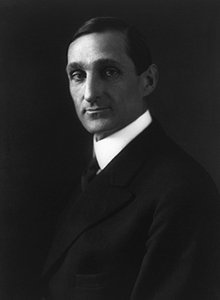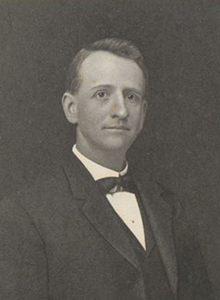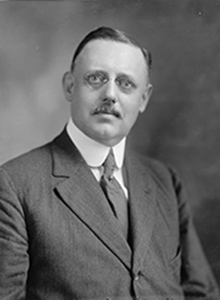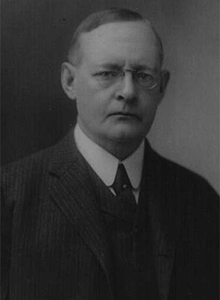
William G. McAdoo
- Treasury Secretary, Federal Reserve Board, 1913 – 1918
- Born: October 31, 1863
- Died: February 1, 1941
William G. McAdoo was sworn in as the secretary of the Treasury on March 6, 1913. As Treasury secretary, McAdoo was a member of the Reserve Bank Organization Committee (RBOC), which under the Federal Reserve Act was responsible for determining the number and location of Federal Reserve Banks and the boundaries of Federal Reserve districts. As Treasury secretary, McAdoo was ex officio chairman of the Federal Reserve Board. McAdoo resigned as Treasury secretary on December 15, 1918.
Born near Marietta, Georgia, in 1863, McAdoo spent his early life in the South. He graduated from the University of Tennessee, practiced law, sold investment securities, and was involved in streetcar railroad companies in both Tennessee and New York.1 McAdoo founded and was president and director of Hudson & Manhattan Railroad Company from 1900 until becoming Treasury secretary in 1913.2 In 1912, he served as the acting chairman of the Democratic National Committee and was active in Woodrow Wilson's presidential campaign.3
As a member of the RBOC, McAdoo along with the Comptroller of the Currency and secretary of Agriculture traveled throughout the United States and heard testimony from bankers and others in support of various cities for Reserve Banks. On August 10, 1914, McAdoo became ex officio chair of the new Federal Reserve Board, where he served along with Comptroller of the Currency John Skelton Williams and the five newly appointed Board members. As Treasury secretary, McAdoo was empowered to choose the date when the 12 new Reserve Banks would open for business, which he set as November 16, 1914.4
McAdoo was closely aligned with President Wilson and others in his cabinet who embraced segregation in government.* Under McAdoo's leadership, the Treasury Department was one of the first cabinet departments to segregate its offices.5 McAdoo was not closely involved in the day-to-day operations of the new Fed, though he believed that the Treasury should dominate and that the Federal Reserve Board should exert strong oversight and authority over the Reserve Banks.
As Treasury secretary at the outbreak of World War I, McAdoo was tasked with financing the country's wartime budget, much of which came from Liberty Loan programs operated by the Fed. When conflicts between the Fed and the Treasury arose, McAdoo sided firmly with the Treasury—for example, threatening to use his legal authority as Treasury secretary to overrule the Reserve Banks when they objected to the low interest rates paid on Treasury securities.6
McAdoo served as Treasury secretary until December 15, 1918. His successor, Carter Glass, took office and assumed the role of ex officio chairman of the Federal Reserve Board the following day.7 McAdoo died in 1941.
* To our readers: This website provides information about individuals who played important roles in Federal Reserve history, some of whom embraced, advocated, or advanced public policies that are wholly inconsistent with our values. This profile and others on this website acknowledge these problematic views and actions. The Federal Reserve History website is committed to transparency in documenting the stories that Fed history reveals and doing so in a manner that is consistent with the Federal Reserve's commitment to education, diversity, equity, and inclusion.
Written by the Board of Governors of the Federal Reserve System in 2013 and updated August 19, 2021, by Genevieve Podleski. See disclaimer.
Endnotes
1 "William Gibbs McAdoo." Volopedia, University of Tennessee, Knoxville, n.d. See also Lowenstein, Roger. America's Bank: The Epic Struggle to Create the Federal Reserve. Penguin Press, 2015: 190-91.
2 "History." Port Authority of New York and New Jersey, n.d. and "'The Public Be Pleased': William Gibbs McAdoo and the Hudson Tubes." Headlights, Electric Railroaders Association, June 1964.
3 "William Gibbs McAdoo." Checks & Balances exhibit, Museum of American Finance, n.d.
4 Meltzer, Allan H. A History of the Federal Reserve, Volume 1. University of Chicago Press, 2010, p. 74.
5 Wolgemuth, Kathleen L. "Woodrow Wilson and federal segregation." The Journal of Negro History 44, no. 2 (1959): 158-173.
6 Meltzer v1 p 86, note 45.
7 Prior Secretaries." U.S. Department of the Treasury, n.d.




 X
X  facebook
facebook
 email
email